
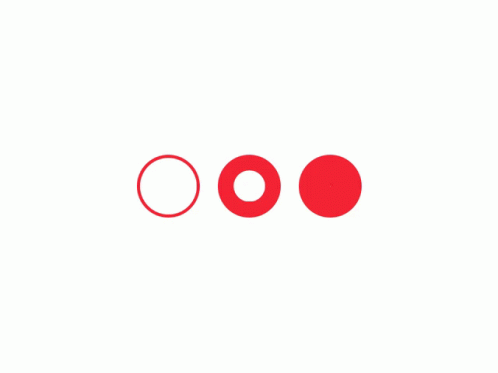


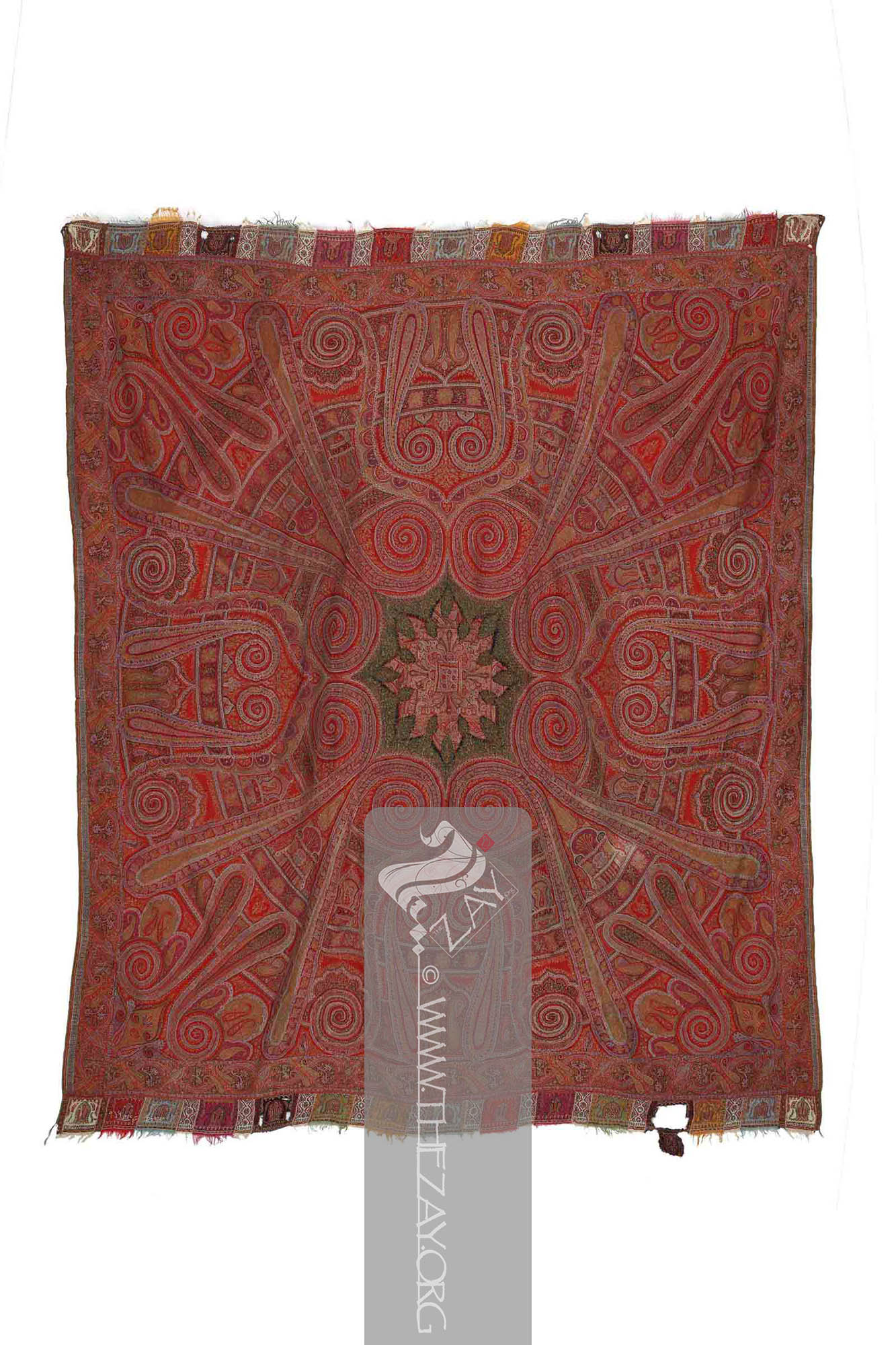
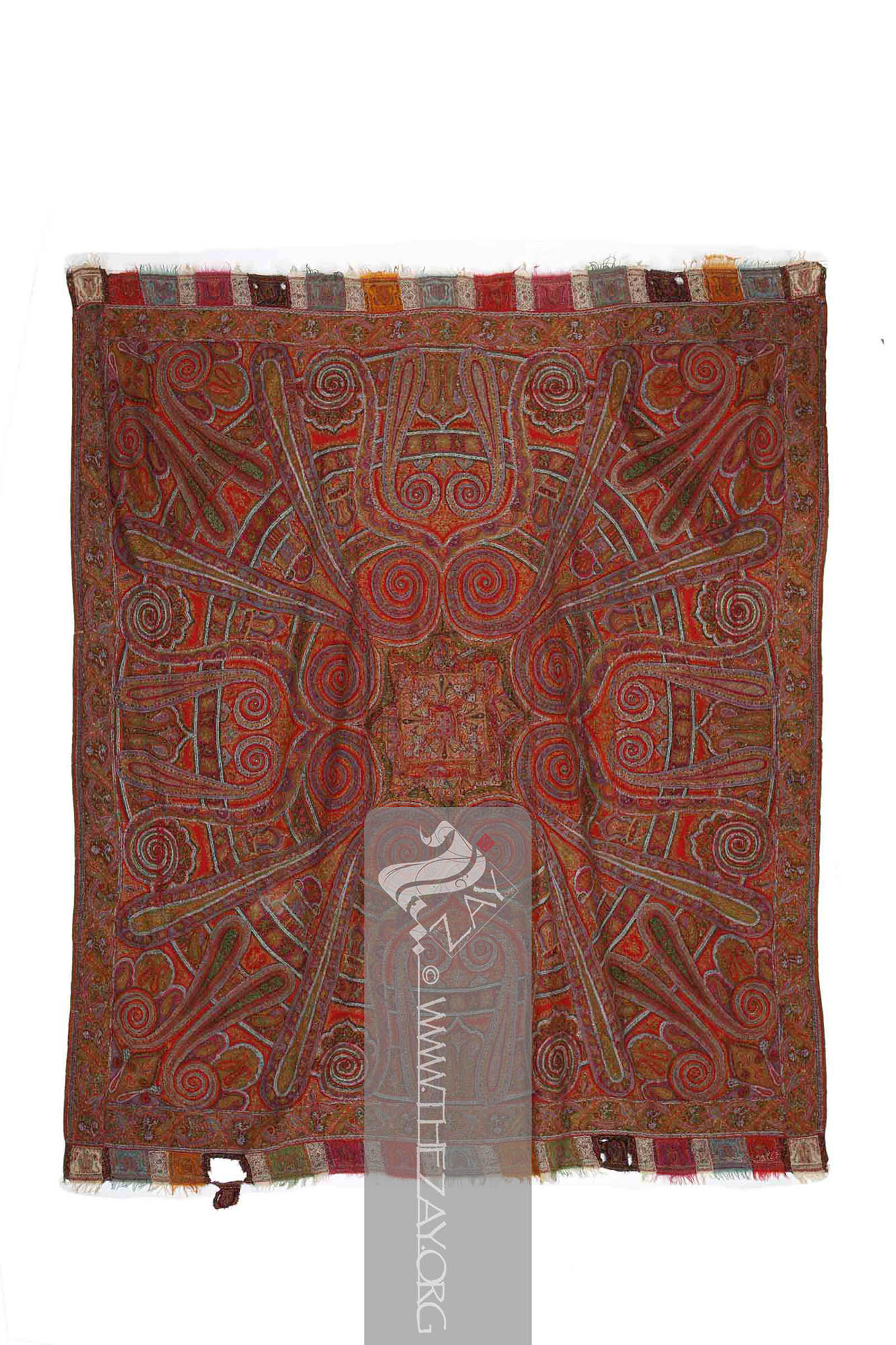
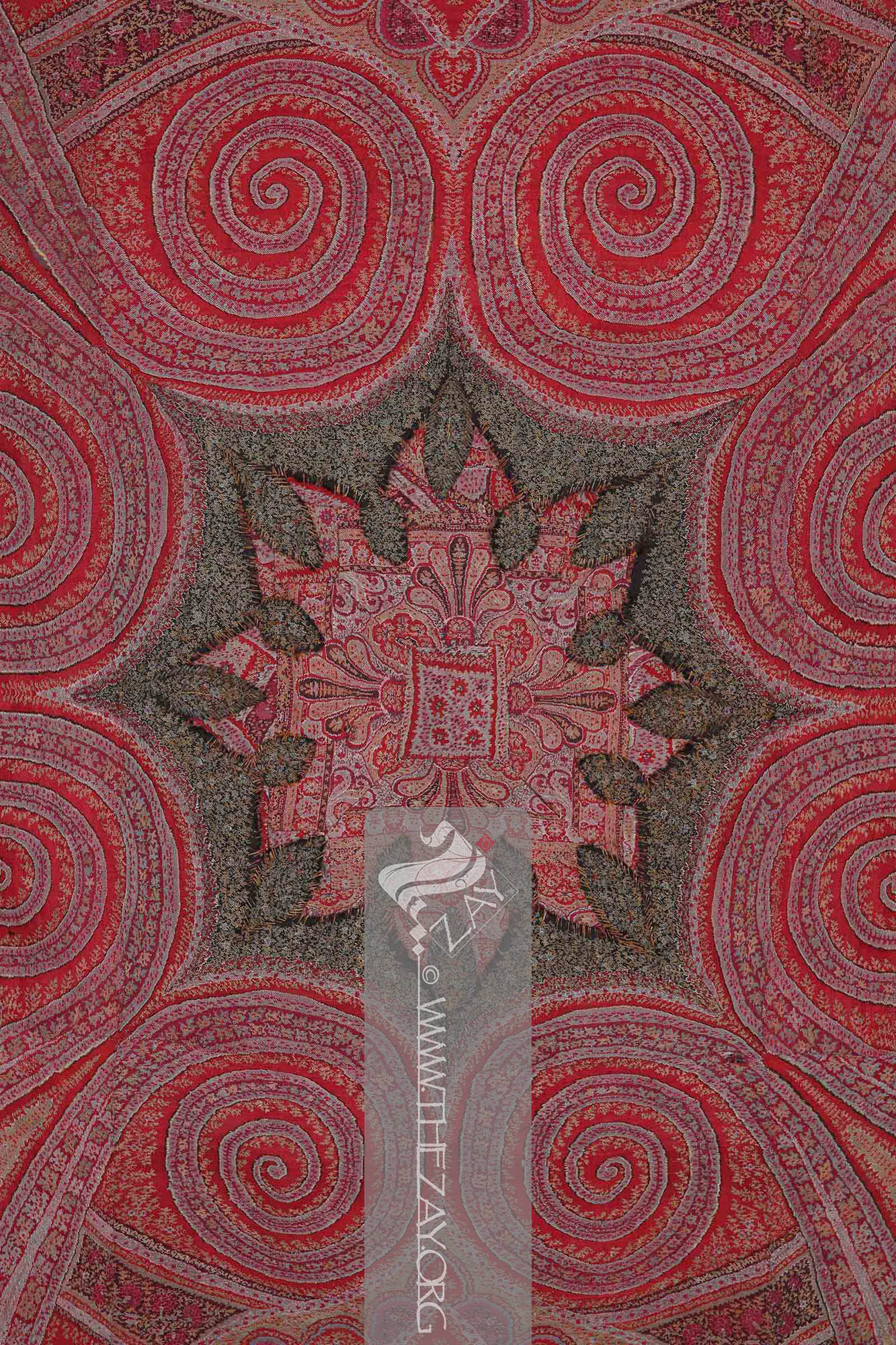
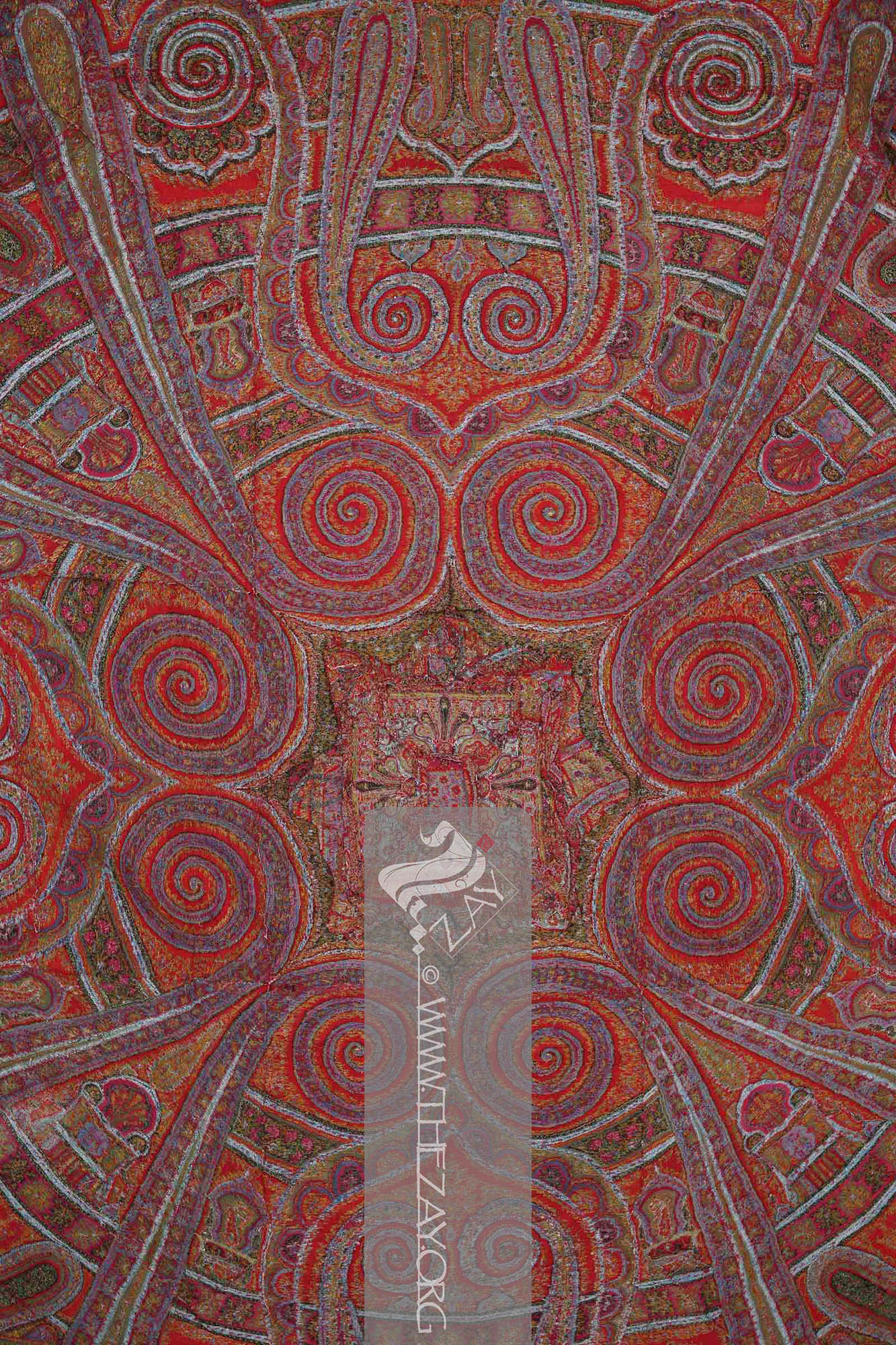
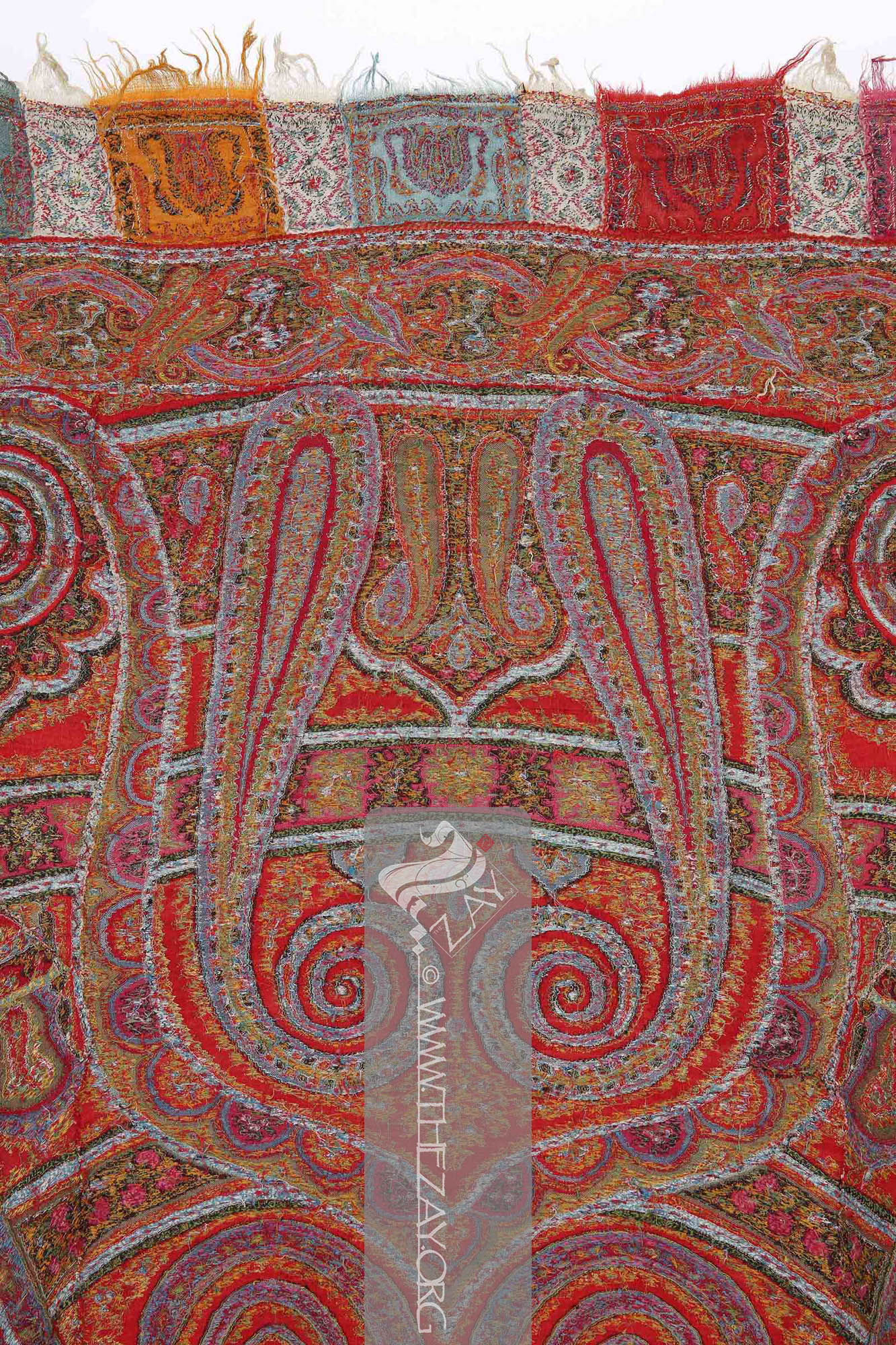

| Local Name | Rumaal, Shal |
| Object Category | Overgarment Cloak |
| Gender | Female |
| Place Of orgin | Asia |
| Region | Kashmir |
| Object Range | India, Pakistan, Bangladesh, Afghanistan, Iran |
| Dimensions | Length: 208cm Width: 181cm |
| Materials | Wool |
| Technique | Hand Stitched Woven |
| Color | |
| Motif | Floral Paisley |
| Provenance | Purchased, Dr Joan Coleman Collection, Kerry Taylor Auctions, London 2020 |
| Location | The Zay Zay: (Arabic: costume, Pl. azyaā’), a set of clothes in a style typical of a particular country or historical period. Initiative |
| Status | In Storage |
| ZI number | ZI2020.500775 ASIA |
Object History
This vibrant polychromatic square (shawl Shawl: (Persian: shāl from Hindi: duśālā – Shoulder Mantle), a shawl is a South Asian version of a scarf worn or wrapped loosely over the shoulders and is usually made of wool. ) dating back to the 19th century was originally a part of the Dr Joan Coleman Collection. It was first purchased at the Broadwater School jumble sale in May 1973. Later The Zay Zay: (Arabic: costume, Pl. azyaā’), a set of clothes in a style typical of a particular country or historical period. Initiative managed to acquire it from Kerry Taylor Auctions in 2020.
Dr Joan Coleman began collecting shawls in 1976 and developed her lifelong passion for collecting. She was a regular at the London salesrooms of Christie’s, Sotheby’s, and Phillips – three of the most outstanding auction houses of the period in the world – getting to know the dealers and learning in the process. She acquired vast knowledge and dedicated hours carefully cataloguing her ever-growing collection. She intended to loan her collection to different museums and institutions for the benefit of learning and education. Her collection is one of the largest and the finest private shawl Shawl: (Persian: shāl from Hindi: duśālā – Shoulder Mantle), a shawl is a South Asian version of a scarf worn or wrapped loosely over the shoulders and is usually made of wool. collections to have ever graced the world with shawls ranging from Kashmir, Paisley Paisley: (Scottish Gaelic, Pàislig: a town in Scotland), often called buta, boteh, amli, or kalgi in the subcontinent and kazuwah in Arabic, is a Persian tear drop motif with a curved end specially in textiles. Its popularity and subsequent local production in 18th century at Paisley are responsible for its nomenclature., Edinburgh, Norwich, France, and Iran.
Object Features
This beautiful and vibrant square piece often referred to as a (rumaal
Rumaal: (Hindi:rumal – handkerchief; from Persian: rū – face, māl – wiper), refers to a small square cloth often made of plain-woven cotton or silk used as handkerchieves, scarves, or headdress in the Indian subcontinent and parts of Central Asia. It can also be used as a decorative accessory for wrapping gifts.) in the Indian subcontinent and perhaps in parts of Central Asia too is a Kashmiri
Kashmiri: (Hindustani: Kashmir – a region in South Asia), a term used to denote or identify anything related to the region – its people, their language, culture, art and craft, society etc. (kani
Kani: (Kashmiri
Kashmiri: (Hindustani: Kashmir – a region in South Asia), a term used to denote or identify anything related to the region – its people, their language, culture, art and craft, society etc. : Small sticks, also a name of a village in Kashmir), a type of weave that originated in this village where wooden bobbins or sticks are used as spools on the loom to create intricate patterns instead of a shuttle. Jamawar: (Hindi, Jama: robe and war/var: chest or body), a portmanteau word meaning anything that covers the body. Originally brocade silk of intricate and overlapping patterns first introduced by the traders from Samarkand and Bukhara to the subcontinent and was adopted in wool specifically in pashmina
Pāshmīna: (Persian: pašm or pashm – wool), pashmina scarves are eponymous woolen shawls from the Kashmir region with a history dating back to more than 500 years. It is the finest variant of spun cashmere wool extracted from the downy undercoat of the Changthangi goats found in the Ladakh province. . Madder: (Latin: Rubia tinctorum – Eurasian herb), rose madder, common madder or dyer's madder is a vegetable dye made from the roots of a perennial plant belonging to the bedstraw and coffee family. It has been used extensively as a vegetable red dye across the globe from India to England.
As a typical Kashmiri Kashmiri: (Hindustani: Kashmir – a region in South Asia), a term used to denote or identify anything related to the region – its people, their language, culture, art and craft, society etc. patchwork shawl Shawl: (Persian: shāl from Hindi: duśālā – Shoulder Mantle), a shawl is a South Asian version of a scarf worn or wrapped loosely over the shoulders and is usually made of wool. of the period this piece is woven in patches and then attached to one another. The central panel of this piece is a star-shaped medallion or an eight-petal bloom woven in bottle green wool. The centre of this panel has intricate woven (paisley Paisley: (Scottish Gaelic, Pàislig: a town in Scotland), often called buta, boteh, amli, or kalgi in the subcontinent and kazuwah in Arabic, is a Persian tear drop motif with a curved end specially in textiles. Its popularity and subsequent local production in 18th century at Paisley are responsible for its nomenclature.)/(buta Būta: (Anglicized Persian: boteh – Pinecone shaped motif), known as paisley Paisley: (Scottish Gaelic, Pàislig: a town in Scotland), often called buta, boteh, amli, or kalgi in the subcontinent and kazuwah in Arabic, is a Persian tear drop motif with a curved end specially in textiles. Its popularity and subsequent local production in 18th century at Paisley are responsible for its nomenclature. in English it is the almond or pinecone-shaped motif, especially in textiles. It is believed to have originated from the Cyprus tree a Zoroastrian symbol for life and eternity. In the current Indian context, however, it simply means motif.) motifs of different sizes, dimensions, and orientations in red, brown, and orange rendering a kaleidoscopic effect.
This central green piece is attached to several other patches that together feature two distinct panels that repeat four times each alternately. One panel comprises two thin elongated paisleys arranged back-to-back along with other intricate floral patterns and (palmettes) forming a triangular peak. The other panel also features two thin elongated paisleys but arranged face to face forms an arch with equally intricate floral patterns and palmettes. Every panel is connected to the other by several thick lines forming circles of varied thickness.
The piece has a square border framing it on all four sides that contains two waves of vines crisscrossing each other forming a chain-like pattern with floral arrangements at regular intervals. The (warp Warp: One of the two basic components used in weaving which transforms thread or yarns to a piece of fabric. The warp is the set of yarns stretched longitudinally in place on a loom before the weft Weft: one of the two basic components used in weaving that transforms thread or yarns into a piece of fabric. It is the crosswise thread on a loom that is passed over and under the warp threads. is introduced during the weaving process. ) ends are finished with bouquets of blooms enclosed within arches woven in patches of different colours – yellow, (scarlet) red, ivory, (turquoise Turquoise: (French: turquois – present day Türkiye; Synonyms: firuze, pheroza), is a naturally occurring opaque mineral mined in abundance in Khorasan province of Iran and has been used for making dye for centuries. The term is a derivative of the French word for the country Türkiye once called Turkey. )/(pheroza Pheroza: (Persian: pērōzah – "victory", later Arabic: fayrūz; Synonyms: firuze, turquoise Turquoise: (French: turquois – present day Türkiye; Synonyms: firuze, pheroza), is a naturally occurring opaque mineral mined in abundance in Khorasan province of Iran and has been used for making dye for centuries. The term is a derivative of the French word for the country Türkiye once called Turkey. ), is a naturally occurring opaque mineral mined in abundance in Khorasan province of Iran and has been used for making dye for centuries. ), moss green and pink – with threads of corresponding colours hanging loose in a series of fringed tassels.
A typical 19th century Kashmiri
Kashmiri: (Hindustani: Kashmir – a region in South Asia), a term used to denote or identify anything related to the region – its people, their language, culture, art and craft, society etc. jamawar
Jamawar: (Hindi, Jama: robe and war/var: chest or body), a portmanteau word meaning anything that covers the body. Originally brocade silk of intricate and overlapping patterns first introduced by the traders from Samarkand and Bukhara to the subcontinent and was adopted in wool specifically in pashmina
Pāshmīna: (Persian: pašm or pashm – wool), pashmina scarves are eponymous woolen shawls from the Kashmir region with a history dating back to more than 500 years. It is the finest variant of spun cashmere wool extracted from the downy undercoat of the Changthangi goats found in the Ladakh province. . Rafugar: (Hindi/Urdu: Rafu meaning darning), a term commonly used in the Indian subcontinent collectively refers to darners, fixers, hand embroiderers, and other needleworkers.
The use of pheroza
Pheroza: (Persian: pērōzah – "victory", later Arabic: fayrūz; Synonyms: firuze, turquoise
Turquoise: (French: turquois – present day Türkiye; Synonyms: firuze, pheroza), is a naturally occurring opaque mineral mined in abundance in Khorasan province of Iran and has been used for making dye for centuries. The term is a derivative of the French word for the country Türkiye once called Turkey. ), is a naturally occurring opaque mineral mined in abundance in Khorasan province of Iran and has been used for making dye for centuries. , black, and ivory with shades of red on a madder
Madder: (Latin: Rubia tinctorum – Eurasian herb), rose madder, common madder or dyer's madder is a vegetable dye made from the roots of a perennial plant belonging to the bedstraw and coffee family. It has been used extensively as a vegetable red dye across the globe from India to England.
With the Zay Zay: (Arabic: costume, Pl. azyaā’), a set of clothes in a style typical of a particular country or historical period. Initiative’s record number of Kashmiri Kashmiri: (Hindustani: Kashmir – a region in South Asia), a term used to denote or identify anything related to the region – its people, their language, culture, art and craft, society etc. shawls and their European counterparts acquired from the Dr Joan Coleman Collection, this piece forms an important and integral part of history as it was the piece acquired by Dr Coleman that inspired and initiated her journey as a private collector.